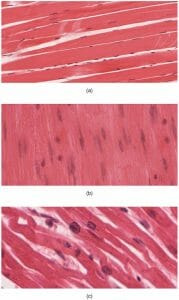Muscle Tissue Definition
Muscle tissue is a specialized tissue found in animals which functions by contracting, thereby applying forces to different parts of the body. Muscle tissue consists of fibers of muscle cells connected together in sheets and fibers. Together these sheets and fibers and known as muscles, and control the movements of an organisms as well as many other contractile functions. There are three different types of muscle found in animals, depending on their use. While these muscles differ slightly, they function in a similar way.
Function of Muscle Tissue
Muscle tissue functions as a single unit, and is often connected to the same nerve bundles. A nerve impulse traveling from the brain or another outside signal tells the muscle to contract. The nerve impulse is transferred almost instantaneously to all the nerve cells in the muscle tissue, and the entire muscle contracts.
At the cellular level, each muscle cell has a complex of proteins containing actin and myosin. These proteins slide past one another when the signal to contract is received. The filaments are connected to the ends of the cells, and as they slide past one another, the cell contracts in length. A single cell can contract up to 70% in length, which shortens the entire muscle when contraction happens. Muscle tissue can be used to move bones, compress chambers, or squeeze various organs. These different types of muscle tissue are discussed below.
Types of Muscle Tissue
Skeletal Muscle Tissue
Skeletal muscle tissue is a type of striated muscle, meaning clear bands can be seen in it under a microscope. This can be seen in image (a) below. These tiny light and dark bands are sarcomeres, highly organized bundles of actin, myosin, and associated proteins. These organized bundles allow striated muscle to contract quickly and release quickly. Muscle tissue is attached to the bones through tendons, which are highly elastic portions of connective tissue. Many muscles may seem to control a single appendage, but in reality each one only controls one small aspect of movement. Skeletal muscle tissue can be controlled voluntarily, by the somatic nervous system. The other types of muscle are controlled mainly by the involuntary or autonomous nervous system.
Cardiac Muscle Tissue
While the striations in skeletal muscle tissue are even and parallel, complex and branching striations are seen in cardiac muscle tissue. Cardiac muscle can be seen in image (c) below. While the striations are hard to see in this image, the branching nature of the cells is easy to pick out. The branching is caused by the connection of cardiac muscle cells to one another. The cells are connected via intercalated discs. These junctures help cardiac muscle to contract as one and provide a rapid and coordinated contraction to move blood.
Smooth Muscle Tissue
Unlike cardiac and skeletal muscle tissue, smooth muscle tissue has no striations. The fibers of myosin and actin in smooth muscle fiber is not nearly as organized as in the other types of muscle tissue. In smooth muscle, the contractions are not quick and rapid but rather smooth and continuous. Smooth muscle is found surrounding many organs, blood vessels, and other vessels used for transporting fluids. The smooth muscle can contract to apply a force on organ. This can be used to move blood or food throughout their respective systems. Smooth muscle is recognizable from its lack of striations and unbranching nature in image (b) below.
Quiz
1. Knowing that actin and myosin are present in muscle cells, a student has a clever idea. If a test for actin and myosin could be developed, cells could quickly be tested to see if they are muscle cells. Will the student’s idea work?
A. Yes, great idea!
B. No, the test could get contaminated by the user
C. No, actin and myosin are in many cells
2. When your muscles are not contracted, they are soft and squishy. When you flex, they get strong and hard. Is muscle considered a soft or hard tissue?
A. Hard
B. Soft
C. Neither
3. Dr. Frankenstein’s monster was created from reanimated parts of dead corpses. Which of the following is not a difficulty Dr. Frankenstein had to overcome to create his monster?
A. Attaching nerves to muscle tissue
B. Rehydrating cells
C. Getting muscle tissue to contract
References
- Lodish, H., Berk, A., Kaiser, C. A., Krieger, M., Scott, M. P., Bretscher, A., . . . Matsudaira, P. (2008). Molecular Cell Biology 6th. ed. New York: W.H. Freeman and Company.

